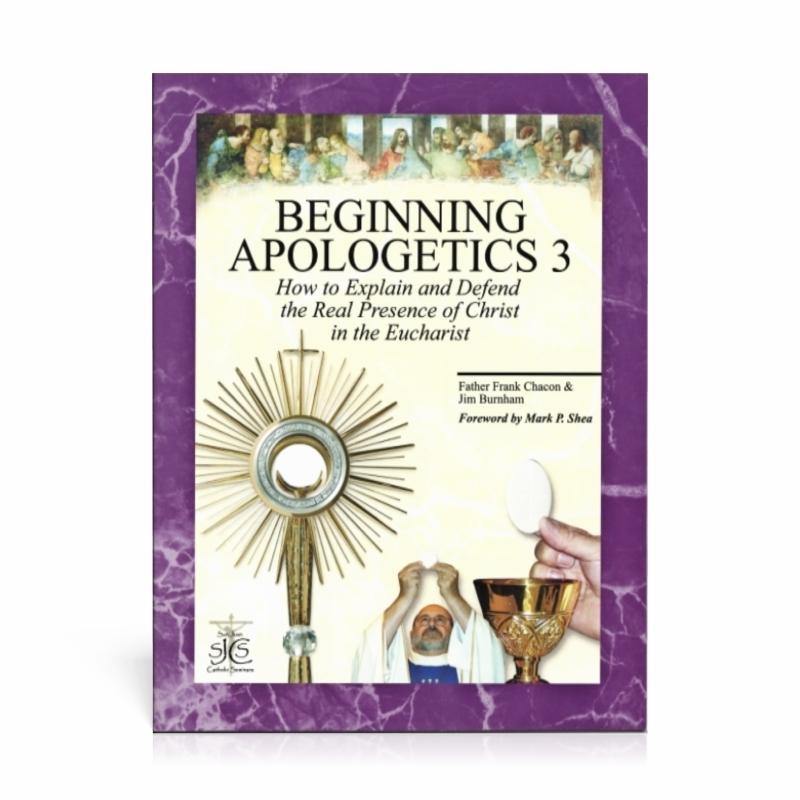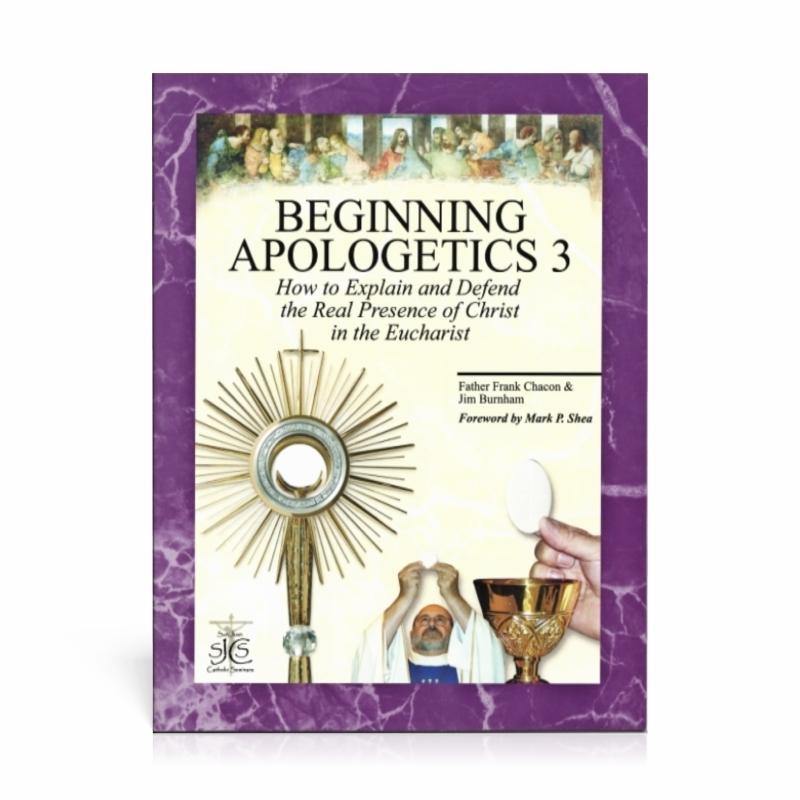Beginning Apologetics 3
Beginning Apologetics 3
Couldn't load pickup availability
- Description
How to Explain and Defend the Real Presence of Christ in the Eucharist
In 1862, St. John Bosco had a remarkable dream. He saw the Catholic Church as a mighty flagship in the midst of a great battle. Smaller enemy ships were bombarding it with books and pamphlets, bombs and cannons, and trying to ram it off course. At the same time, huge waves and fierce winds buffeted the flagship. At the helm, the Pope strained every muscle to steer his ship between two mighty columns in the sea. On the smaller column stood a statue of the Blessed Virgin Mary. On the other, far loftier column, was a large Host. In spite of all adversity, the Pope anchored the flagship to thick chains hanging from the two columns. At that, the enemy ships panicked and fled, while the wind and seas grew calm.
St. John Bosco explained that the Church will endure grave trials and persecutions. The Church’s enemies will try their utmost to destroy her. But two things will preserve the Church in that hour: devotion to Mary and frequent Communion.
Bosco’s vision illustrates that the greatest treasure in the Catholic Church is the Eucharist. In it, Jesus humbly assumes the appearance of bread and wine, proving his desire to be bodily connected to us.
Because it is Jesus himself, the Eucharist is the heart of the Catholic faith. The new Catechism of the Catholic Church calls the Eucharist the "source and summit of the Christian life" and the "sum and the summary of our faith" (CCC, sections 1324 and 1327). It’s hard to imagine that any Catholic could misunderstand the central doctrine of his faith.
However, according to an alarming 1992 Gallup poll, the majority of Catholics are confused in their beliefs about Christ’s presence in the Eucharist:
- 30% believe they are really and truly receiving the body, blood, soul and divinity of the Lord Jesus Christ under the appearance of bread and wine.
- 29% believe they are receiving bread and wine that symbolize the body and blood of Jesus.
- 10% believe they receive bread and wine in which Jesus is also present.
- 24% believe they are receiving what has become Christ’s body and blood because of their personal belief.
Any well-informed Catholic will recognize that only the first option, chosen by the 30 percent, represents true Catholic teaching. The other options represent various Protestant beliefs. In other words, nearly 70 percent of all Catholics in this country hold erroneous beliefs about Christ's presence in the Eucharist.
The problem increases dramatically among younger Catholics. According to a more recent New York Times and CBS poll of Catholics who attend Mass regularly, the number of Catholics who accept the Real Presence decreases as age decreases:
- Age 65 and over: 51% believe in the Real Presence
- Age 45 - 64: 37% believe in the Real Presence
- Age 30 - 44: 28% believe in the Real Presence
- Age 18 - 29: 17% believe in the Real Presence
Contents
- Forward by Mark P. Shea
- Introduction
- What Does the Church Teach About the Eucharist?
- Three Ways Jesus is Present
- Why Should We Believe in the Real Presence?
- The Biblical Basis for the Real Presence
- The Eucharist Prefigured in the Old Testament
- The Eucharist Fulfilled in the New Testament
- The Historical Basis for the Real Presence
- Evidence from the Early Church Fathers
- Evidence from History
- Evidence from Eucharistic Miracles
- A Saint's Summary
- I Believe! Now What Should I Do?
- Appreciate the Eucharist More Fully
- Receive the Eucharist More Fruitfully
- Pass the Faith on to Our Children More Permanently
- Evangelize our Separated Brethren More Effectively
- A Saint's Reflection
- Conclusion
- Holy Communion Prayers
- Prayer of St. Thomas Aquinas (before Communion)
- Prayer of St. Thomas Aquinas (after Communion)
- Pange Lingua (Tantum Ergo)
- Adoro Te (translated by Gerard Manley Hopkins, S.J.)
- Glossary of Terms
- Recommended Resources
Authors: Father Frank Chacon & Jim Burnham Format: 8.5x11" softcover. 40 pages
Share
Let customers speak for us
from 5966 reviewsThis book is beautiful. I cried, but it is beautifully written and illustrated. Our parish Pro-Life Group recently saw our dream of a pro-life lending library, for our church, come to fruition. This book was purchased for that purpose and wil, hopefully, help those who have lost a child.
This is going to be such a wonderful addition to my kids tree this Christmas season. I love this!
Very nice and meaningful. Pope John died when I was 12 years old but I remember the news announcement of his passing. I purchased 10 cards to give to my friends at church.
A story to fill one with more love for our Holy God. It is such a beautiful little book.
Fantastic resource for kids
Beautifully written and illustrated book!
I highly recommend buying this book for families who have lost a baby through miscarriage. It gives a great explanation on something that is hard to explain to children.
It's a tale of a BEAUTIFUL journey to God - a real solace even after 46 years' loss. ♥️
This case is perfect! I love it.
Perfect book for my 8yr old grandson who is baptized Catholic but not being brought up in a practicing home. It’s a perfect way to introduce him to a young saint.
My granddaughter was born on the feast of Our Lady of Guadalupe so I’m always looking for things to help her grow in her devotion. She is 8yrs old and the book is perfect for her
Fit perfect and looked great!
Nicer and more detailed than I imagined. Kids of various ages will enjoy learning about this saint as they color the pictures.
The prayers cards so wonderful, thank you so much for your brilliant work! We might be ordering more.... God bless you always!
Great case! Beautiful image, useful message for first responders, easily visible, and very protective if you do drop your phone.





